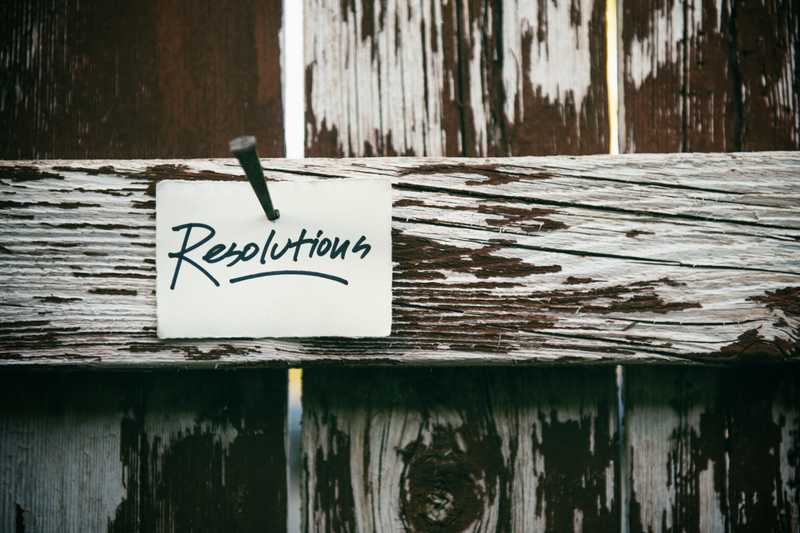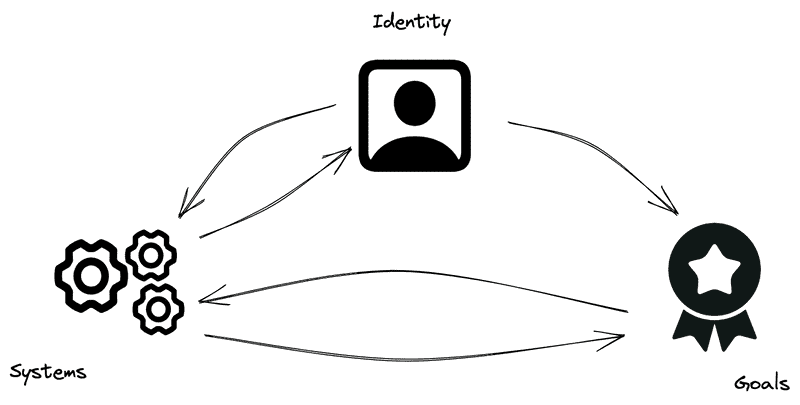Identity, Goals, and Systems: A Better Approach to 2023 Resolutions
January 03, 2023
Photo by Tim Mossholder on Unsplash
While wandering the streets during New Year’s Eve several years ago (pre-COVID), I came upon a tree. Our fellow NYE participants had covered the tree with small strips of paper using bits of twine or string to affix them to the branches. On each was a short phrase written in squiggly marker with phrases like “Get in shape,” “Get on a budget,” or “Stop drinking.” Each was a resolution for the coming year.
I wondered: how many people gave more than 30 seconds of thought to their so-called resolution? Did they ever write it down somewhere else? How will they remember it?
Our culture loves the idea of a resolution and making significant changes about ourselves in the New Year. But we know the data: most resolutions don’t work. Resolutions are often vague, unplanned, and without any accountability structure - ingredients required for successful behavior change. If we want to change our lives in the coming year, we need more than a resolution: we need actionable goals and a system to put them in place.
A popular book on behavior change is the now famous Atomic Habits by James Clear. A famous quote from the book is this:
You don’t rise to the level of your goals; you fall to the level of your systems
The idea is that to achieve goals, we have to do the work ahead of time to develop a system or a plan in which to accomplish it. If you want to work out more, you need to state which gym, what time, for how long, etc. You should pick some form of workout plan ahead of time. If you show up at the gym and have to create an agenda on the spot, you are likely to be disengaged, do a short workout, see no results, and ultimately quit.
If we want to achieve our goals, we need to develop systems. But how do we choose our goals? We need to look somewhere else for that.
We need to start with identity.
Identity
When we start with external forces such as systems and goals, we divorce them from our internal motivation. We forget the why. We come up with goals that, even well-intentioned, can feel arbitrary or forced.
When we start with identity, however, we flip the whole thing on its head. We begin with internal motivation rather than external motivation. We start to think about the person we are becoming. We start to consider the (hard!) questions of “Who am I?” “Who do I want to become?” “What do I want?”
These questions are hard to answer because they are the core of who we are. The Greek Philosophers, the Stoics, the ancient Israelites, and nearly all other people groups throughout history have had to find answers to these questions.
Even after we find our identity, we often forget it. It sounds cliche, but it’s true: we forget who we are. We get caught up following trends, responding to the crisis of the day, or simply treading water.
But we can take time to meditate, reflect, and find our identities amidst the chaos. It isn’t easy, but it’s worth it.
We all have multiple identities too. We need not find one perfect moniker for who we are: engineers, activists, athletes, designers, enthusiasts, and more. But defining a few core identities can help us understand ourselves better.
When looking for these identities, it can often be as simple as observing what your natural behaviors are already. As we will get into, our daily behaviors are often formed by habits or patterns. We create - intentionally or unintentionally - systems for how to live.
Think about your identities and those you want to have, and let those drive your next steps.
Goals
Once we have formed our identities (which might take a while), we often start to think of goals. We begin thinking, “If I am this kind of person, what would this kind of person achieve this year?”
For example, I’m a climber. I love climbing, and my love for it has only grown in the past few years. And what do climbers do? They climb. This year I want to climb consistently and achieve a V7 boulder problem and a 5.11+ route.
Another example might be someone who considers themselves a software leader (whether as a tech lead, a Staff role, a distinguished role, or even an open source maintainer). They might step back and wonder how they can further their identity as a leader. It might mean getting a new certification this upcoming year, learning a new language, or speaking at a conference. It could also be a goal to help someone on your team get promoted.
In either case, there is an identity formed and a few goals worth pursuing.
But how do those goals get achieved? How does the proverbial rubber meet the road toward success? Simply writing it on a piece of paper left on a tree on NYE won’t work.
We need some form of plan. We need to create a system.
Systems
Once we have defined an identity to reinforce and goals to help us do that, we need to create systems that help us achieve those goals.
Systems are a fancy way to talk about an ongoing plan. They often become a set of habits and schedules that dictate how and what we do. They help us “automate” decision-making ahead of time, which means we aren’t affected by our emotions or whims at the time. All we have to do is follow the system. Makings plans ahead of time always seem to be good indications of making better decisions, such as checklists.
Back to the climber example, I want to reinforce my identity as a climber by climbing regularly. I’d also like to be able to climb a V7 and a 5.11 (indoor) by the end of the year. These are my goals.
To reach those goals, I’ve set in my calendar that every Monday, Wednesday, and Friday, I go climbing for an hour and a half. I’ve also set aside Saturday mornings to focus on top roping with a partner (since the middle of the day is not a common time of day to find climbing partners). I’ve also purchased a training book that I will incorporate into my schedule once it arrives.
I’m also 100% confident my system will need to change; that’s ok. The point isn’t to get the system 100% right; it’s to have one and be willing to make tweaks as needed.
Identity and Systems Continue Beyond the Goal
One of the other key ideas from Atomic Habits and building systems is that building systems outlive goals. Goals are temporary by nature; we either achieve them or realize we never will. What happens when either of these two events occurs? If I can’t reach my goal of climbing a V7 boulder this year, does that mean I’m not a climber? I wouldn’t think so.
But by having a system, we can continue to reinforce our identity. Who we are and what we do isn’t dictated by our achieving or not achieving specific goals but by how we choose to live our lives every day. All three of these components work together a bit like this:
Our identity shapes our goals and systems. Our goals inform and lead to our systems. And finally, our systems continue to reinforce our identity, lasting longer than our goals.
Let’s Start With Identity
Let’s move away from resolutions and arbitrary goals. Let’s discover who we are and who we want to be. Then let’s create the systems to help us get there.
To be clear, it is challenging to live this way. It takes grit and effort. I still struggle to create the patterns and systems I want. But I am working towards it, which is half the battle. Few things worth doing are easy.
Happy coding! And a happy New Year!
Here is a short template I used for my own goals this year. I wrote one of these for each identity on a different page in my journal.
Identity: an identity I want to reinforce
Why/What: short paragraph describing why I want to reinforce that identity and what that kind of person is like
Goals: 2-3 short goals for the year; 1-2 goals long term goals to act as guideposts
System: specify a (rough) plan for when/how I reinforce that identity and push for my goals
Here are some more resources I’ve found helpful:
- A blog on Better Habits from Ryan Holiday
- The aforementioned book Atomic Habits book from James Clear
- A summary of “Don’t Break the Chain” used by Jerry Seinfeld
If you enjoyed this article, you should join my newsletter! Every other Tuesday, I send you tools, resources, and a new article to help you build great teams that build great software.
Dan Goslen is a software engineer, climber, and coffee drinker. He has spent 10 years writing software systems that range from monoliths to micro-services and everywhere in between. He's passionate about building great software teams that build great software. He currently works as a software engineer in Raleigh, NC where he lives with his wife and son.

